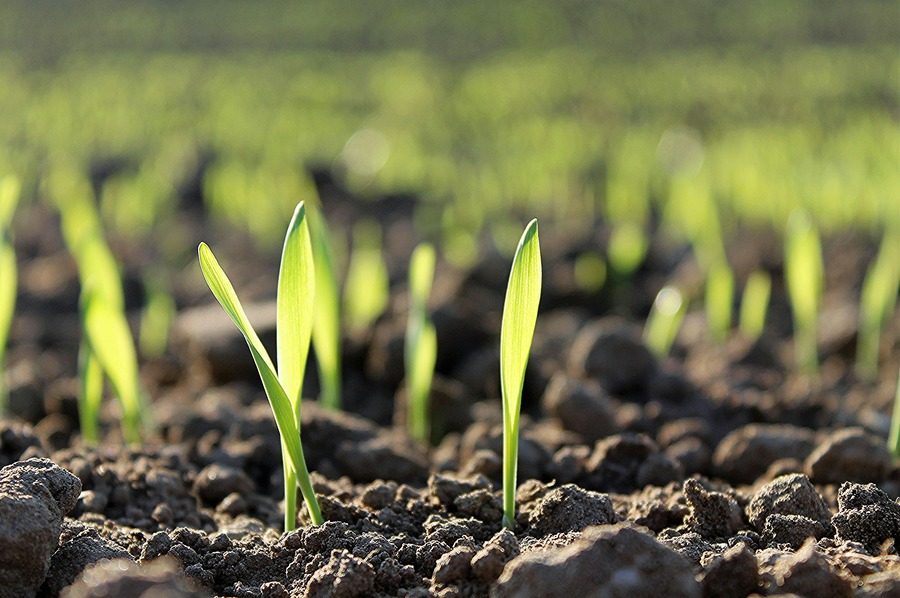
Plant nutrition depends on how plants absorb nutrients from the soil solution through various processes. Simplified, these are categorised into three types: mass flow, diffusion, and interception. Understanding these processes is essential for farmers aiming to optimise fertilisation and improve crop yields. In this post, we’ll explore how these nutrient absorption mechanisms work and what factors influence their efficiency.
Nutrient uptake mechanisms in plants
Plants absorb soil nutrients through three primary processes:
- Mass flow is the process where the plant absorbs soil water during transpiration, along with the dissolved nutrients. Through this process, 99% of the nitrogen required by plants is taken up as easily mobile nitrate (NO3-) ions, while only about 20% of potassium (K) is absorbed. Since NO3- ions are negatively charged, they are not affected by the negative electrical charge of the soil particles, making them fully dissolved and highly mobile in the soil water.
- Diffusion is the process where nutrients move (very slowly) to the root zone due to concentration differences. Through diffusion, plants absorb a significant portion of their needed potassium (K) and most micronutrients. Nutrient cations are bound by the negative surface charges of soil colloidal particles (clay particles, organic matter), and the movement of these cations between soil particles, soil water, and the plant is significantly influenced by soil texture, cation exchange capacity (CEC) mechanism, soil moisture, and temperature. Most phosphorus (P) is also absorbed through diffusion, as it is very immobile and generally insoluble in water, and its uptake is linked to chemical reactions and soil pH levels.
- Interception is a form where the plant roots move into direct contact with soil nutrients. Its role in overall nutrition is small, as the root surface only touches about 1-2% of the total surface area of soil particles.
Secondary nutrients and environmental factors
For secondary nutrients like magnesium (Mg) and calcium (Ca), their absorption and movement depend significantly on soil moisture. Under high moisture conditions, mass flow is the main mechanism; under low moisture, diffusion plays a larger role. Magnesium and calcium are important exchangeable cations, and their presence in the soil—either in the soil solution or bound to soil surfaces—is largely determined by soil texture, CEC value, moisture content, and temperature. As a result, the concentration of Mg and Ca in the soil solution remains relatively constant, contributing to the initial nutrient levels (INL), measured at early spring without fertilisers, but not changing significantly during the growing season. Soil water acts as a buffer for exchangeable cations, keeping ion concentrations in solution stable and preventing rapid changes in soil solution electrical conductivity.
Nitrogen’s role in plant growth
The most important macronutrient for plants, nitrogen, is absorbed by plants in its nitrate (NO3-) form. NO3-N is highly mobile and a fast-moving nutrient—it is either taken up by the plant or leaches with the movement of soil water. Changes in Paul-Tech nutrient indicators during the growing season, relative to INL value, are mainly due to NO3-N, and its dynamics allow us to quantitatively estimate the amount of dissolved and plant-available NO3-N in the soil, expressed in mg/kg or kg/ha during the whole growing season.
Ammonium nitrogen (NH4+) is present in the soil as a cation, which is very immobile and bound to soil structures, thus contributing little to electrical conductivity. Ammonium nitrogen (and organic nitrogen present in the soil) only becomes available to plants after undergoing nitrification, a process carried out by soil bacteria that converts it into NO3–. At that point, it is directly reflected in the PT nutrient indicators, and the nitrification process, including the amount of NO3-N produced (kg/ha), can be tracked in PT nutrient graphs.
Electrical indicators from the soil
Among the secondary nutrients, sulphur (SO4²⁻) ions also significantly affect electrical measurements. Similar to NO3-, sulphate anions are not influenced by the electrically charged surfaces of soil particles and are mobile in the soil solution. The impact of NO3 and SO4 on PT nutrient indicators can be assessed based on the fertilisers used.
Phosphorus and its limited mobility
Phosphorus (P) is a very immobile and water-insoluble nutrient, and its (very slow) movement in the soil and uptake by plants is not directly reflected in soil solution electrical conductivity or Paul-Tech nutrient indicators.
Summary
The Paul-Tech nutrient indicator includes all nutrients currently present in the soil solution. The influence of different elements on this indicator is described by their contribution to the mass flow uptake mechanism. The initial nutrient level (INL) characterizes soil fertility, or the total nutrient content, without added mineral nitrogen (NO3), and is a soil characteristic that does not change significantly during the growing season.
The dynamics of nutrient indicators during the growing season are largely driven by changes in NO3-N content due to fertiliser dissolution in the soil, plant uptake, or leaching. Based on Paul-Tech nutrient indicators and graphs, the amount of NO3-N in the soil can be quantified in mg/kg or kg/ha. For fertilisers containing SO4, sulphate ion levels and their changes are also reflected in the nutrient indicator.